Sahara
| Sahara | |
|---|---|
Arabic : الصحراء الكبرى | |
| Geography | |
| Countries | |
| Coordinates | 23°N 13°E / 23°N 13°E |
The Sahara (/səˈhɑːrə/, /səˈhærə/) is a desert spanning across North Africa. With an area of 9,200,000 square kilometres (3,600,000 sq mi), it is the largest hot desert in the world and the third-largest desert overall, smaller only than the deserts of Antarctica and the northern Arctic.[1][2][3]
The name "Sahara" is derived from
The desert covers much of North Africa, excluding the fertile region on the Mediterranean Sea coast, the Atlas Mountains of the Maghreb, and the Nile Valley in Egypt and the Sudan.[8]
It stretches from the
For several hundred thousand years, the Sahara has alternated between desert and savanna grassland in a 20,000-year cycle[9] caused by the precession of Earth's axis (about 26,000 years) as it rotates around the Sun, which changes the location of the North African monsoon.
Geography

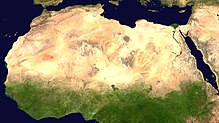
The Sahara covers large parts of
The Sahara is mainly rocky
Several deeply dissected mountains, many volcanic, rise from the desert, including the
The central Sahara is
To the north, the Sahara skirts the
To the south, the Sahara is bounded by the Sahel, a belt of dry
Important cities located in the Sahara include Nouakchott, the capital of Mauritania; Tamanrasset, Ouargla, Béchar, Hassi Messaoud, Ghardaïa, and El Oued in Algeria; Timbuktu in Mali; Agadez in Niger; Ghat in Libya; and Faya-Largeau in Chad.
Climate
The Sahara is the world's largest
The permanent absence of clouds allows unhindered light and thermal radiation. The
The rainfall inhibition and the dissipation of cloud cover are most accentuated over the eastern section of the Sahara rather than the western. The prevailing
The effects of local surface low pressure are extremely limited because upper-level subsidence still continues to block any form of air ascent. Also, to be protected against rain-bearing weather systems by the atmospheric circulation itself, the desert is made even drier by its geographical configuration and location. Indeed, the extreme aridity of the Sahara is not only explained by the subtropical high pressure: the Atlas Mountains of Algeria, Morocco and Tunisia also help to enhance the aridity of the northern part of the desert. These major mountain ranges act as a barrier, causing a strong rain shadow effect on the leeward side by dropping much of the humidity brought by atmospheric disturbances along the polar front which affects the surrounding Mediterranean climates.
The primary source of rain in the Sahara is the
Temperature
The sky is usually clear above the desert, and the
The high position of the Sun, the extremely low relative humidity, and the lack of
Other hot spots in Algeria such as Adrar, Timimoun, In Salah, Ouallene, Aoulef, Reggane with an elevation between 200 and 400 metres (660 and 1,310 ft) above sea level get slightly lower summer average highs, around 46 °C (114.8 °F) during the hottest months of the year. Salah, well known in Algeria for its extreme heat, has average high temperatures of 43.8 °C (110.8 °F), 46.4 °C (115.5 °F), 45.5 °C (113.9 °F) and 41.9 °C (107.4 °F) in June, July, August and September respectively. There are even hotter spots in the Sahara, but they are located in extremely remote areas, especially in the Azalai, lying in northern Mali. The major part of the desert experiences around three to five months when the average high strictly[clarification needed] exceeds 40 °C (104 °F); while in the southern central part of the desert, there are up to six or seven months when the average high temperature strictly[clarification needed] exceeds 40 °C (104 °F). Some examples of this are Bilma, Niger and Faya-Largeau, Chad. The annual average daily temperature exceeds 20 °C (68 °F) everywhere and can approach 30 °C (86 °F) in the hottest regions year-round. However, most of the desert has a value in excess of 25 °C (77 °F).

Sand and ground temperatures are even more extreme. During daytime, the sand temperature is extremely high: it can easily reach 80 °C (176 °F) or more.[22] A sand temperature of 83.5 °C (182.3 °F) has been recorded in Port Sudan.[22] Ground temperatures of 72 °C (161.6 °F) have been recorded in the Adrar of Mauritania and a value of 75 °C (167 °F) has been measured in Borkou, northern Chad.[22]
Due to lack of cloud cover and very low humidity, the desert usually has high
Precipitation
The average annual rainfall ranges from very low in the northern and southern fringes of the desert to nearly non-existent over the central and the eastern part. The thin northern fringe of the desert receives more winter cloudiness and rainfall due to the arrival of
The vast central hyper-arid core of the desert is virtually never affected by northerly or southerly atmospheric disturbances and permanently remains under the influence of the strongest anticyclonic weather regime, and the annual average rainfall can drop to less than 1 millimetre (0.04 in). In fact, most of the Sahara receives less than 20 millimetres (0.8 in). Of the 9,000,000 square kilometres (3,500,000 sq mi) of desert land in the Sahara, an area of about 2,800,000 square kilometres (1,100,000 sq mi) (about 31% of the total area) receives an annual average rainfall amount of 10 millimetres (0.4 in) or less, while some 1,500,000 square kilometres (580,000 sq mi) (about 17% of the total area) receives an average of 5 millimetres (0.2 in) or less.[25]
The annual average rainfall is virtually zero over a wide area of some 1,000,000 square kilometres (390,000 sq mi) in the eastern Sahara comprising deserts of: Libya, Egypt and Sudan (
Desertification and prehistoric climate
One theory for the formation of the Sahara is that the monsoon in Northern Africa was weakened because of glaciation during the Quaternary period, starting two or three million years ago. Another theory is that the monsoon was weakened when the ancient Tethys Sea dried up during the Tortonian period around 7 million years ago.[28]
The climate of the Sahara has undergone enormous variations between wet and dry over the last few hundred thousand years,
The idea that changes in

During the last
Lake Chad is the remnant of a former inland sea, paleolake Mega-Chad, which existed during the African humid period. At its largest extent, sometime before 5000 BCE, Lake Mega-Chad was the largest of four Saharan paleolakes, and is estimated to have covered an area of 350,000 km2.[37]
The
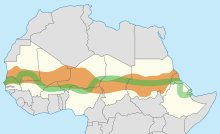
It is also proposed that humans accelerated the drying-out period from 6000 to 2500 BCE by pastoralists overgrazing available grassland.[39]
Evidence for cycles
The growth of
During the
The sudden subsequent movement of the ITCZ southwards with a
Ecoregions
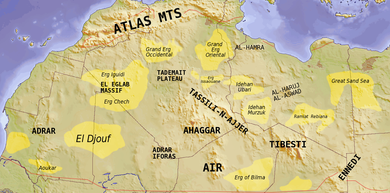
The Sahara comprises several distinct ecoregions. With their variations in temperature, rainfall, elevation, and soil, these regions harbor distinct communities of plants and animals.
- The Atlantic coastal desert is a narrow strip along the Atlantic coast where fog generated offshore by the cool Canary Current provides sufficient moisture to sustain a variety of lichens, succulents, and shrubs. It covers an area of 39,900 square kilometers (15,400 sq mi) in the south of Morocco and Mauritania.[44]
- The North Saharan steppe and woodlands is along the northern desert, next to the Mediterranean forests, woodlands, and scrub ecoregions of the northern Maghreb and Cyrenaica. Winter rains sustain shrublands and dry woodlands that form a transition between the Mediterranean climate regions to the north and the hyper-arid Sahara proper to the south. It covers 1,675,300 square kilometers (646,840 sq mi) in Algeria, Egypt, Libya, Mauritania, Morocco, and Tunisia.[45]
- The Sahara desert ecoregion covers the hyper-arid central portion of the Sahara where rainfall is minimal and sporadic. Vegetation is rare, and this ecoregion consists mostly of sand dunes (erg, chech, raoui), stone plateaus (hamadas), gravel plains (reg), dry valleys (wadis), and salt flats. It covers 4,639,900 square kilometres (1,791,500 sq mi) of: Algeria, Chad, Egypt, Libya, Mali, Mauritania, Niger, and Sudan.[12]
- The South Saharan steppe and woodlands ecoregion is a narrow band running east and west between the hyper-arid Sahara and the Sahel savannas to the south. Movements of the equatorial Intertropical Convergence Zone (ITCZ) bring summer rains during July and August which average 100 to 200 mm (4 to 8 in) but vary greatly from year to year. These rains sustain summer pastures of grasses and herbs, with dry woodlands and shrublands along seasonal watercourses. This ecoregion covers 1,101,700 square kilometres (425,400 sq mi) in Algeria, Chad, Mali, Mauritania, and Sudan.[46]
- In the West Saharan montane xeric woodlands, several volcanic highlands provide a cooler, moister environment that supports Saharo-Mediterranean woodlands and shrublands. The ecoregion covers 258,100 square kilometres (99,650 sq mi), mostly in the Tassili n'Ajjer of Algeria, with smaller enclaves in the Aïr of Niger, the Adrar Plateau of Mauritania, and the Adrar des Iforas of Mali and Algeria.[47]
- The
- The Saharan halophytics is an area of seasonally flooded saline depressions which is home to Chott Melghir in Algeria, and smaller areas of Algeria, Mauritania, and the southern part of Morocco.[49]
- The Tanezrouft is one of the Sahara's most arid regions, with no vegetation and very little life. A barren, flat gravel plain, it extends south of Reggane in Algeria towards the Adrar des Ifoghas highlands in northern Mali.
Flora and fauna
The flora of the Sahara is highly diversified based on the bio-geographical characteristics of this vast desert. Floristically, the Sahara has three zones based on the amount of rainfall received – the Northern (Mediterranean), Central and Southern Zones. There are two transitional zones – the Mediterranean-Sahara transition and the Sahel transition zone.[50]
The Saharan flora comprises around 2800 species of vascular plants. Approximately a quarter of these are endemic. About half of these species are common to the flora of the Arabian deserts.[51]
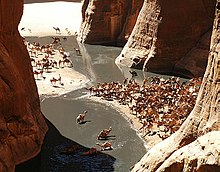
The central Sahara is estimated to include five hundred species of plants, which is extremely low considering the huge extent of the area. Plants such as acacia trees, palms, succulents, spiny shrubs, and grasses have adapted to the arid conditions, by growing lower to avoid water loss by strong winds, by storing water in their thick stems to use it in dry periods, by having long roots that travel horizontally to reach the maximum area of water and to find any surface moisture, and by having small thick leaves or needles to prevent water loss by evapotranspiration. Plant leaves may dry out totally and then recover.
Several species of fox live in the Sahara including: the fennec fox, pale fox and Rüppell's fox. The addax, a large white antelope, can go nearly a year in the desert without drinking. The dorcas gazelle is a north African gazelle that can also go for a long time without water. Other notable gazelles include the rhim gazelle and dama gazelle.
The Saharan cheetah (northwest African cheetah) lives in Algeria, Togo, Niger, Mali, Benin, and Burkina Faso. There remain fewer than 250 mature cheetahs, which are very cautious, fleeing any human presence. The cheetah avoids the sun from April to October, seeking the shelter of shrubs such as balanites and acacias. They are unusually pale.[52][53] The other cheetah subspecies (northeast African cheetah) lives in Chad, Sudan and the eastern region of Niger. However, it is currently extinct in the wild in Egypt and Libya. There are approximately 2000 mature individuals left in the wild.
Other animals include the
The deathstalker scorpion can be 10 cm (3.9 in) long. Its venom contains large amounts of agitoxin and scyllatoxin and is very dangerous; however, a sting from this scorpion rarely kills a healthy adult. The Saharan silver ant is unique in that due to the extreme high temperatures of their habitat, and the threat of predators, the ants are active outside their nest for only about ten minutes per day.[57]
Dromedary camels and goats are the domesticated animals most commonly found in the Sahara. Because of its qualities of endurance and speed, the dromedary is the favourite animal used by nomads.
Human activities are more likely to affect the habitat in areas of permanent water (oases) or where water comes close to the surface. Here, the local pressure on natural resources can be intense. The remaining populations of large mammals have been greatly reduced by hunting for food and recreation. In recent years development projects have started in the deserts of Algeria and Tunisia using irrigated water pumped from underground aquifers. These schemes often lead to
Researchers from Hacettepe University have reported that Saharan soil may have bio-available iron and also some essential macro and micro nutrient elements suitable for use as fertilizer for growing wheat.[58]
History
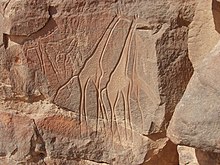
People lived on the edge of the
Kiffians
The
Tenerians
Gobero was discovered in 2000 during an archaeological expedition led by Paul Sereno, which sought dinosaur remains. Two distinct prehistoric cultures were discovered at the site: the early Holocene Kiffian culture, and the middle Holocene Tenerian culture. The post-Kiffian desiccation lasted until around 4600 BCE, when the earliest artefacts associated with the Tenerians have been dated to. Some 200 skeletons have been discovered at Gobero. The Tenerians were considerably shorter in height and less robust than the earlier Kiffians. Craniometric analysis also indicates that they were osteologically distinct. The Kiffian skulls are akin to those of the Late Pleistocene Iberomaurusians, early Holocene Capsians, and mid-Holocene Mechta groups, whereas the Tenerian crania are more like those of Mediterranean groups.[67][68] Graves show that the Tenerians observed spiritual traditions, as they were buried with artifacts such as jewelry made of hippo tusks and clay pots. The most interesting find is a triple burial, dated to 5300 years ago, of an adult female and two children, estimated through their teeth as being five and eight years old, hugging each other. Pollen residue indicates they were buried on a bed of flowers. The three are assumed to have died within 24 hours of each other, but as their skeletons hold no apparent trauma (they did not die violently) and they have been buried so elaborately – unlikely if they had died of a plague – the cause of their deaths is a mystery.

Tashwinat Mummy
Uan Muhuggiag appears to have been inhabited from at least the 6th millennium BCE to about 2700 BCE, although not necessarily continuously.[69] The most noteworthy find at Uan Muhuggiag is the well-preserved mummy of a young boy of approximately 2+1⁄2 years old. The child was in a fetal position, then embalmed, then placed in a sack made of antelope skin, which was insulated by a layer of leaves.[70] The boy's organs were removed, as evidenced by incisions in his stomach and thorax, and an organic preservative was inserted to stop his body from decomposing.[71] An ostrich eggshell necklace was also found around his neck.[69] Radiocarbon dating determined the age of the mummy to be approximately 5600 years old, which makes it about 1000 years older than the earliest previously recorded mummy in ancient Egypt.[72] In 1958–59, an archaeological expedition led by Antonio Ascenzi conducted anthropological, radiological, histological and chemical analyses on the Uan Muhuggiag mummy. The team claimed that the mummy was a 30-month-old child of uncertain sex. They also found a long incision on the specimen's abdominal wall, which indicated that the body had been initially mummified by evisceration and later underwent natural desiccation. The team also stated that the mummy possessed "Negroid features."[73] However, modern genetics has since proven that the final claim is unscientific and not supported by evidence.[74][75] A more recent publication referenced a laboratory examination of the cutaneous features of the child mummy in which the results verified that the child possessed a dark skin complexion.[76] One other individual, an adult, was found at Uan Muhuggiag, buried in a crouched position.[69] However, the body showed no evidence of evisceration or any other method of preservation. The body was estimated to date from about 7500 BP.[77]
Nubians

During the
Egyptians
By 6000 BCE
By 3400 BCE, the Sahara was as dry as it is today, due to reduced precipitation and higher temperatures resulting from a shift in Earth's orbit.[35] As a result of this aridification, it became a largely impenetrable barrier to humans, with the remaining settlements mainly being concentrated around the numerous oases that dot the landscape. Little trade or commerce is known to have passed through the interior in subsequent periods, the only major exception being the Nile Valley. The Nile, however, was impassable at several cataracts, making trade and contact by boat difficult.
Tichitt culture
In 4000 BCE, the start of sophisticated social structure (e.g., trade of cattle as valued assets) developed among herders amid the
As areas where the Tichitt cultural tradition were present, Dhar Tichitt and Dhar Walata were occupied more frequently than Dhar Néma.[97] Farming of crops (e.g., millet) may have been a feature of the Tichitt cultural tradition as early as 3rd millennium BCE in Dhar Tichitt.[97]
As part of a broader trend of iron metallurgy developed in the West African Sahel amid 1st millennium BCE, iron items (350 BCE – 100 CE) were found at Dhar Tagant, iron metalworking and/or items (800 BCE – 400 BCE) were found at Dia Shoma and Walaldé, and the iron remnants (760 BCE – 400 BCE) found at Bou Khzama and Djiganyai.[97] The iron materials that were found are evidence of iron metalworking at Dhar Tagant.[92] In the late period of the Tichitt Tradition at Dhar Néma, tamed pearl millet was used to temper the tuyeres of a oval-shaped low shaft furnace; this furnace was one out of 16 iron furnaces located on elevated ground.[91] Iron metallurgy may have developed before the second half of 1st millennium BCE, as indicated by pottery dated between 800 BCE and 200 BCE.[91] At Dhar Walata and Dhar Tichitt, copper was also used.[88]
After its decline in Mauritania, the Tichitt Tradition spread to the
Phoenicians
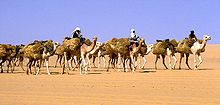
The people of Phoenicia, who flourished from 1200 to 800 BCE, created a chain of settlements along the coast of North Africa and traded extensively with its inhabitants. This put them in contact with the people of ancient Libya, who were the ancestors of people who speak Berber languages in North Africa and the Sahara today.
The Libyco-Berber alphabet of the ancient Libyans of north Africa seems to have been based on Phoenician, and its descendant Tifinagh is still used today by the (Berber) Tuareg of the central Sahara.
The Periplus of the Phoenician navigator Hanno, who lived sometime in the 5th century BC, claims that he founded settlements along the Atlantic coast of Africa, possibly including the Western Sahara. The identification of the places discussed is controversial, and archeological confirmation is lacking.
Greeks
By 500 BCE, Greeks arrived in the desert. Greek traders spread along the eastern coast of the desert, establishing trading colonies along the Red Sea. The Carthaginians explored the Atlantic coast of the desert, but the turbulence of the waters and the lack of markets caused a lack of presence further south than modern Morocco. Centralized states thus surrounded the desert on the north and east; it remained outside the control of these states. Raids from the nomadic Berber people of the desert were of constant concern to those living on the edge of the desert.
Garamantes

An urban civilization, the
Between the first century BCE and the fourth century CE, several
Islamic and Arabic expansion
The
The
Ottoman Turkish era
In the 16th century the northern fringe of the Sahara, such as coastal regencies in present-day
European colonialism
The French took advantage of long-standing animosity between the

The French Colonial Empire was the dominant presence in the Sahara. It established regular air links from Toulouse (HQ of famed Aéropostale), to Oran and over the Hoggar to Timbuktu and West to Bamako and Dakar, as well as trans-Sahara bus services run by La Compagnie Transsaharienne (est. 1927).[103] A remarkable film shot by famous aviator Captain René Wauthier in 1933 documents the first crossing by a large truck convoy from Algiers to Tchad, across the Sahara.[104]
Egypt, under Muhammad Ali and his successors, conquered Nubia in 1820–22, founded Khartoum in 1823, and conquered Darfur in 1874. Egypt, including Sudan, became a British protectorate in 1882. Egypt and Britain lost control of the Sudan from 1882 to 1898 as a result of the Mahdist War. After its capture by British troops in 1898, the Sudan became an Anglo-Egyptian condominium.
Breakup of the empires and afterwards

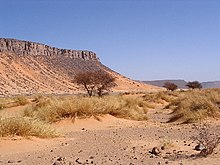
Egypt became independent of Britain in 1936, although the Anglo-Egyptian treaty of 1936 allowed Britain to keep troops in Egypt and to maintain the British-Egyptian condominium in the Sudan. British military forces were withdrawn in 1954.
Most of the Saharan states achieved independence after World War II: Libya in 1951; Morocco, Sudan, and Tunisia in 1956; Chad, Mali, Mauritania, and Niger in 1960; and Algeria in 1962. Spain withdrew from Western Sahara in 1975, and it was partitioned between Mauritania and Morocco. Mauritania withdrew in 1979; Morocco continues to hold the territory (see Western Sahara conflict).[105]
Tuareg people in Mali rebelled several times during the 20th century before finally forcing the Malian armed forces to withdraw below the line demarcating Azawad from southern Mali during the 2012 rebellion.[106] Islamist rebels in the Sahara calling themselves al-Qaeda in the Islamic Maghreb have stepped up their violence in recent years.[107]
In the post–World War II era, several mines and communities have developed to use the desert's natural resources. These include large deposits of oil and natural gas in Algeria and Libya, and large deposits of phosphates in Morocco and Western Sahara.[108] Libya's Great Man-Made River is the world's largest irrigation project.[109] The project uses a pipeline system that pumps fossil water from the Nubian Sandstone Aquifer System to cities in the populous Libyan northern Mediterranean coast including Tripoli and Benghazi.[110]
A number of
People, culture, and languages
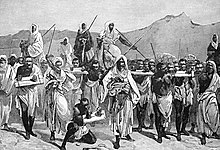
The people of the Sahara are of various origins. Among them the
See also
- African humid period – Holocene climate period during which northern Africa was wetter than today
- Arid Lands Information Network
- List of deserts
- List of deserts by area – List of the largest deserts in the world by area
- List of Saharan explorers
- Sahara Conservation Fund – International conservation organization
- Sahara Sea – Engineering project to flood parts of the Sahara Desert with sea water
- Trans-Saharan slave trade – Slave trade
References
- .
- ^ "Largest Desert in the World". Archived from the original on 17 August 2007. Retrieved 30 December 2011.
- ^ "Is the World Full or Empty?". Story Maps. Archived from the original on 15 January 2022. Retrieved 19 October 2018.
- ^ "Sahara." Archived 11 February 2009 at the Wayback Machine Online Etymology Dictionary. Douglas Harper, Historian. Retrieved 25 June 2007.
- ^ "English-Arabic online dictionary". Online.ectaco.co.uk. 28 December 2006. Archived from the original on 9 March 2009. Retrieved 12 June 2010.
- ISBN 978-0-87950-003-0.
- ^ al-Ba'labakkī, Rūḥī (2002). al-Mawrid: Qāmūs 'Arabī-Inklīzī (in Arabic) (16th ed.). Beirut: Dār al-'Ilm lil-Malāyīn. p. 689.
- ^ "Sahara | Location, History, Map, Countries, Animals, & Facts | Britannica". www.britannica.com. Archived from the original on 16 April 2023. Retrieved 16 April 2023.
- ^ Chu, Jennifer (2 January 2019). "A "pacemaker" for North African climate". MIT News. Archived from the original on 15 January 2022. Retrieved 20 January 2020.
- S2CID 85443933.
- ISBN 0-471-85064-0. p. 347
- ^ a b "Sahara desert". Terrestrial Ecoregions. World Wildlife Fund. Retrieved 30 December 2007.
- ISBN 978-3-540-52171-6
- ^ JSTOR 1790942.
- ^ a b Bisson, J. (2003). Mythes et réalités d'un désert convoité: le Sahara (in French). L'Harmattan.
- ^ ASIN B008MR69VM.
- ^ "The 10 Largest Deserts In The World". WorldAtlas. 13 October 2020. Archived from the original on 19 December 2021. Retrieved 18 January 2022.
- ^ WPS. "Interesting Facts About the Sahara Desert". www.globaladventurechallenges.com. Archived from the original on 16 April 2023. Retrieved 16 April 2023.
- ISBN 978-1-135-85552-9. Archivedfrom the original on 30 July 2023. Retrieved 20 November 2020.
- ^ ISBN 978-1-4020-3264-6. Archivedfrom the original on 30 July 2023. Retrieved 20 November 2020.
- ISBN 978-0-675-09994-3. Archivedfrom the original on 30 July 2023. Retrieved 25 August 2020.
- ^ ISBN 978-1-139-50024-1. Archivedfrom the original on 30 July 2023. Retrieved 20 November 2020.
- PMID 11687629.
- from the original on 18 January 2022, retrieved 18 January 2022
- ^ ISBN 978-3-540-85192-9. Archivedfrom the original on 30 July 2023. Retrieved 20 November 2020.
- ISBN 978-1-4832-1663-8. Archivedfrom the original on 30 July 2023. Retrieved 20 November 2020.
- ^ "Snow falls in Sahara for first time in 37 years". CNN. 21 December 2016. Archived from the original on 23 December 2016. Retrieved 22 December 2016.
- S2CID 205240355.
- ^ .
- S2CID 12698952.
- ^ ISBN 978-0-7167-3741-4.
- S2CID 10388125.
- ^ Ehret, Christopher, The Civilizations of Africa, University Press of Virginia, 2002.
- ^ Fezzan Project — Palaeoclimate and environment. Retrieved 15 March 2006. Archived 7 June 2009 at the Wayback Machine
- ^ a b c Sahara's Abrupt Desertification Started by Changes in Earth's Orbit Archived 7 March 2014 at the Wayback Machine, Accelerated by Atmospheric and Vegetation Feedbacks.
- S2CID 9045667. Archived from the original(PDF) on 3 March 2016. Retrieved 22 February 2013.
- from the original on 21 May 2020. Retrieved 19 July 2020.
- ^ Spoorthy Raman (3 August 2023). "Progress is slow on Africa's Great Green Wall, but some bright spots bloom". Mongabay. Archived from the original on 4 April 2024. Retrieved 4 April 2024 – via news.mongabay.com.
- ^ Boissoneault, Lorraine (24 March 2017). "What Really Turned the Sahara Desert From a Green Oasis into a Wasteland?". Smithsonian. Archived from the original on 28 December 2021. Retrieved 15 August 2017.
- doi:10.1130/G23794A.1. Archived from the original(PDF) on 21 July 2011.
- ORNL Oak Ridge National Laboratory. Archived from the originalon 1 May 2006.
- S2CID 42372016.
- ^ Burroughs, William J. (2007) "Climate Change in Prehistory: the end of the reign of chaos" (Cambridge University Press)
- ^ "Atlantic coastal desert". Terrestrial Ecoregions. World Wildlife Fund. Retrieved 29 December 2007.
- ^ "North Saharan steppe and woodlands". Terrestrial Ecoregions. World Wildlife Fund. Retrieved 29 December 2007.
- ^ "South Saharan steppe and woodlands". Terrestrial Ecoregions. World Wildlife Fund. Retrieved 29 December 2007.
- ^ "West Saharan montane xeric woodlands". Terrestrial Ecoregions. World Wildlife Fund. Retrieved 29 December 2007.
- ^ "Tibesti-Jebel Uweinat montane xeric woodlands". Terrestrial Ecoregions. World Wildlife Fund. Retrieved 29 December 2007.
- ^ "Saharan halophytics". Terrestrial Ecoregions. World Wildlife Fund. Retrieved 29 December 2007.
- ISBN 978-0-8061-3146-7. Archivedfrom the original on 30 July 2023. Retrieved 15 November 2015.
- ISBN 978-3-540-85192-9. Archivedfrom the original on 30 July 2023. Retrieved 15 November 2015.
- ^ "Rare cheetah captured on camera". BBC News. 24 February 2009. Archived from the original on 1 August 2010. Retrieved 12 June 2010.
- . Retrieved 13 November 2021.
- . Retrieved 13 November 2021.
- ^ Borrell, Brendan (19 August 2009). "Endangered in South Africa: Those Doggone Conservationists". Slate. Archived from the original on 30 April 2011.
- ^ "Desert-Adapted Crocs Found in Africa Archived 22 July 2018 at the Wayback Machine", National Geographic News, 18 June 2002
- S2CID 11774194.
- ^ Yücekutlu, Nihal; Terzioğlu, Serpil; Saydam, Cemal; Bildacı, Işık (2011). "Organic Farming By Using Saharan Soil: Could It Be An Alternative To Fertilizers?" (PDF). Hacettepe Journal of Biology and Chemistry. 39 (1): 29–38. Retrieved 23 March 2015.[permanent dead link]
- ^ Discover Magazine Archived 6 June 2017 at the Wayback Machine, 2006-Oct.
- from the original on 7 November 2021. Retrieved 24 May 2021.
- ^ National Geographic News Archived 22 July 2018 at the Wayback Machine, 17 June 2006.
- .
- ^ a b "Stone Age Graveyard Reveals Lifestyles of A 'Green Sahara'". Science Daily. 15 August 2008. Archived from the original on 16 August 2008. Retrieved 15 August 2008.
- ^ a b Wilford, John Noble (14 August 2008). "Graves Found From Sahara's Green Period". The New York Times. Archived from the original on 23 January 2012. Retrieved 15 August 2008.
- PMID 18701936.
- ^ Schultz, Nora (14 August 2008). "Stone Age mass graves reveal green Sahara". New Scientist. Retrieved 15 August 2008.
- PMID 18701936.
- ^ Wilford, John Noble (14 August 2008). "In the Sahara, Stone Age graves from greener days". The New York Times. The New York Times. Archived from the original on 8 March 2021. Retrieved 10 June 2016.
- ^ ISBN 88-7062-971-6.
- ^ Hooke, C. (Director), & Mosely, G. (Producer) (2003). Black Mummy of the Green Sahara (Discovery Channel).
- ISBN 0-521-23020-9.
- ^ "Wan Muhuggiag". Archived from the original on 16 October 2015. Retrieved 16 November 2015.
- PMID 20731247. Archived from the original(PDF) on 25 November 2016. Retrieved 24 November 2016.
- ^ American Association of Physical Anthropologists (27 March 2019). "AAPA Statement on Race and Racism Archived 22 March 2020 at the Wayback Machine". American Association of Physical Anthropologists. Retrieved 27 Nov 2021
- ISBN 978-1-4438-4579-3. Archivedfrom the original on 30 July 2023. Retrieved 6 April 2023.
- ISBN 978-1-4438-4007-1.
- ^ "History of Nubia". Anth.ucsb.edu. Archived from the original on 21 June 2010. Retrieved 12 June 2010.
- ^ The History of Astronomy. PlanetQuest
- ^ Wendorf, Fred (1998) Late Neolithic megalithic structures at Nabta Playa.
- ^ Gatto, Maria C. "The Nubian Pastoral Culture as Link between Egypt and Africa: A View from the Archaeological Record". Archived from the original on 10 May 2022. Retrieved 24 June 2022.
- ^ Fayum, Qarunian Archived 5 November 2007 at the Wayback Machine (Fayum B, about 6000–5000 BCE?), Digital Egypt Archived 16 April 2010 at the Wayback Machine.
- ^ Predynastic (5,500–3,100 BCE), Tour Egypt.
- S2CID 49229774.
- ^ a b c Brass, Michael. "The Emergence of Mobile Pastoral Elites during the Middle to Late Holocene in the Sahara". ResearchGate. Journal of African Archaeology. Archived from the original on 27 February 2022. Retrieved 24 May 2021.
- ^ PMID 24089595.
- ^ a b Abd-El-Moniem, Hamdi Abbas Ahmed. "A New Recording of Mauritanian Rock Art" (PDF). University College London. Archived (PDF) from the original on 31 August 2021. Retrieved 24 May 2021.
- ^ a b c Kea, Ray. "Expansions and Contractions: World-Historical Change And The Western Sudan World-System (1200/1000 B.C. - 1200/1250 A.D.)". ResearchGate. Journal of World-Systems Research. Archived from the original on 27 February 2022. Retrieved 24 May 2021.
- ^ ISBN 9780190277734. Archivedfrom the original on 28 November 2021. Retrieved 24 May 2021.
- from the original on 18 November 2018. Retrieved 24 May 2021.
- ^ ISBN 9789077922309. Archivedfrom the original on 30 July 2023. Retrieved 24 May 2021.
- ^ from the original on 18 May 2021. Retrieved 24 May 2021.
- ISBN 9781108494441. Archivedfrom the original on 30 July 2023. Retrieved 24 May 2021.
- PMID 33758626.
- S2CID 248132575.
- .
- ^ a b c d MacDonald, Kevin C.; Vernet, Robert; Martinon-Torres, Marcos; Fuller, Dorian Q. "Dhar Néma: From early agriculture to metallurgy in southeastern Mauritania". ResearchGate. Azania Archaeological Research in Africa. Archived from the original on 27 September 2022. Retrieved 24 May 2021.
- ^ a b MacDonald, K.C. "Betwixt Tichitt and the IND: the pottery of the Faita Facies, Tichitt Tradition". Dokumen. Azania: Archaeological Research in Africa. Archived from the original on 13 May 2021. Retrieved 24 May 2021.
- ^ Mattingly et al. (2003). Archaeology of Fazzan, Volume 1
- ^ Keys, David (2004). "Kingdom of the Sands". Archaeology. Vol. 57, no. 2.
- ISBN 0-415-25248-2. p. 256
- ^ Trans-Saharan Africa in World History, Ch. 6, Ralph Austin
- ^ "Wauthier Bréard 1933" (in French). Archived from the original on 13 April 2021. Retrieved 22 February 2013.
- ^ Wauthier, René. "Reconnaissance saharienne". French Cinema Archives (in French). Archived from the original on 12 April 2013. Retrieved 22 February 2013.
- ^ "Algeria recalls envoy to Morocco in row over Western Sahara". Al-Jazeera. 18 July 2021. Archived from the original on 28 February 2022. Retrieved 19 July 2021.
- ^ "Mali Tuareg rebels declare independence in the north". BBC News. 6 April 2012. Archived from the original on 21 January 2022. Retrieved 19 July 2021.
- ^ "Al-Qaeda in North Africa appoints new leader to replace Droukdel". France 24. 22 November 2020. Archived from the original on 7 November 2021. Retrieved 19 July 2021.
- ^ "The Desert Rock That Feeds the World". The Atlantic. 29 November 2016. Archived from the original on 25 February 2022. Retrieved 19 July 2021.
- ^ "Libya's Qaddafi taps 'fossil water' to irrigate desert farms". CSMonitor.com. 23 August 2010. Archived from the original on 19 January 2022. Retrieved 19 July 2021.
- ^ Moutaz Ali (2017). "The Eighth Wonder of the World?". Quantara.de. Archived from the original on 19 December 2021. Retrieved 19 July 2021.
- PMID 21187416.
- ISBN 978-0-253-21784-4pp. 49–68
- ISBN 0-19-979883-4
- ISBN 1-317-97001-2
Bibliography
- Brett, Michael; Prentess, Elizabeth (1996). The Berbers. Blackwell Publishers.
- Bulliet, Richard W. (1975). The Camel and the Wheel. Harvard University Press. ISBN 9780674091306. Republished with a new preface Columbia University Press, 1990.
- Gearon, Eamonn (2011). The Sahara: A Cultural History. Signal Books (UK), Oxford University Press (US).
- Julien, Charles-Andre (1970). History of North Africa: From the Arab Conquest to 1830. Praeger.
- Kennedy, Hugh (1996). Muslim Spain and Portugal: A Political History of al-Andalus. Longman.
- Laroui, Abdallah Laroui (1977). The History of the Maghrib: An Interpretive Essay. Princeton.
- Scott, Chris (2005). Sahara Overland. Trailblazer Guides.
- Wade, Lizzie (2015). "Drones and Satellites Spot Lost Civilizations in Unlikely Places". Science. .
External links
- About Sahara subsurface hydrology and planned usage of the aquifers
- Heawood, Edward; Cana, Frank Richardson (1911). . Encyclopædia Britannica. Vol. 23 (11th ed.). pp. 1004–1008.
